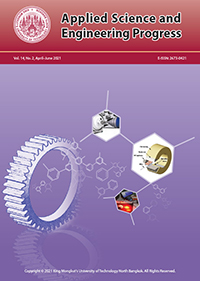Comparison of the Flow Behaviours of Physical and Numerical Models on a Stepped Spillway
Main Article Content
Abstract
A massive water release can create high discharge and high velocity, which in turn can lead to erosion at the surface of a spillway. The difficulties of data collection and the high cost of experiments impose barriers to the study of large spillways. A numerical model that can simulate the flow behaviour is a valid choice to solve this problem. The objective of this research is to study the flow behaviour and flow velocity triggered by physical model tests and numerical model simulations. The small differences between the results of the two models illustrate that the numerical model is reliable and can be used to design a stepped spillway. Computational fluid dynamics (CFD) is a numerical modelling technique used in this study. For the numerical modelling of turbulence, the k–epsilon turbulence model is used. This model comprises 3 submodels: The standard k–epsilon, renormalized group (RNG) k–epsilon and realizable k–epsilon models. The results show that the RNG k–epsilon model is the most suitable model. The results reveal that the stepped spillway results in a 98% reduction of energy dissipation based on the present case study. The quantified differences between the results of the physical model and those of the numerical model are approximately 0.1–11.23%.
Article Details
References
[2] R. M. Sorensen, “Stepped spillway hydraulic model investigation,”Journal of Hydraulic Engineering, vol. 111, no. 12, pp. 1461–1472, 1985.
[3] G. C. Christodoulou, “Energy dissipation on stepped spillways,” Journal of Hydraulic Engineering, vol. 119, no. 5, pp. 644–650, 1993.
[4] F. Salmasi and M. Ozger, “Neuro-fuzzy approach for estimating energy dissipation in skimming flow over stepped spillways,” Arabian Journal for Science and Engineering, vol. 39, no. 8, pp. 6099–6108, 2014.
[5] H. Torabi, A. Parsaie, H. Yonesi, and E. Mozafari, “Energy dissipation on rough stepped spillways,” Iranian Journal of Science and Technology, vol. 42, pp. 325–330, 2018.
[6] A. Parsaie and A. H. Haghiabi, “The hydraulic investigation of circular crested stepped spillway,” Flow Measurement and Instrumentation, vol. 70, p. 101624, 2019.
[7] H. Chanson, “Stepped spillway flows and air entrainment,” Canadian Journal of Civil Engineering, vol. 20, no. 3, pp. 422–435, 1993.
[8] A. Parsaie, A. H. Haghiabi, M. Saneie, and H. Torabi, “Prediction of energy dissipation on the stepped spillway using the multivariate adaptive regression splines,” ISH Journal of Hydraulic Engineering, vol. 22, no.3, pp. 281–292, 2016.
[9] A. H. Haghiabi, H. M. Azamathulla, and A. Parsaie, “Prediction of head loss on cascade weir using ANN and SVM,” ISH Journal of Hydraulic Engineering, vol. 23, no.1, pp. 102–110, 2017.
[10] A. Parsaie, A. H. Haghiabi, M. Saneie, and H. Torabi, “Applications of soft computing techniques for prediction of energy dissipation on stepped spillway,” Neural Computing and Applications, vol. 29, no.12, pp. 1393–1409, 2018.
[11] S. Dehdar-behbahani and A. Parsaie, “Numerical modeling of flow pattern in dam spillway’s guide wall. Case study: Balaroud dam, Iran,” Alexandria Engineering Journal, vol. 55, no. 1, pp. 467–473, 2016.
[12] A. Parsaie, S. Dehdar-Behbahani, and A. H. Haghiabi, “Numerical modeling of cavitation on spillway’s flip bucket,” Frontiers of Structural and Civil Engineering, vol. 10, no. 4, pp. 438–444, 2016.
[13] A. Parsaie, A. H. Haghiabi, M. Saneie, and H. Torabi, “Prediction of energy dissipation of flow over stepped spillways using data-driven models,” Iranian Journal of Science and Technology, Transactions of Civil Engineering, vol. 42, no. 1, pp. 39–53, 2018.
[14] K. W. Frizell and H. K. Frizell, “Guidelines for hydraulic design of stepped spillways,” in Hydraulic Laboratory Report Hl-2015-06. Colorado: U.S. Department of Interior, 2015, pp. 1–38.
[15] A. A. Sonin, The Physical Basis of Dimensional Analysis. 2nd ed. Massachusetts: Massachusetts Institute of Technology, 2001, pp. 9–53.
[16] V. Kulkarni and N. Sahoo, “Module 6 : Lecture 1 dimensional analysis (Part - I.),” 2019. [Online]. Available: https://nptel.ac.in/ courses/101103004/ pdf/mod6.pdf
[17] Y. Srihiran, P. Sumphun, and T. Kuljitjuawong, “Study of flow behavior on stepped spillway case study: Mae Suai Dam in Chiang Rai,” B.S. thesis, Department of Civil Engineering, Faculty of Engineering, King Mongkut’s University of Technology Thonburi, 2016.
[18] M. M. R. Tabari and S. Tavakoli, “Effects of stepped spillway geometry on flow pattern and energy dissipation,” Arabian Journal for Science and Engineering, vol. 41, pp. 1215–1224, 2015.
[19] S. Terrier, A. Schleiss, and M. Fister, Hydraulic Performance of Stepped Spillway Aerators and Related Downstream Flow Features. Lausanne, Switzerland: EPFL, 2016, p. 360.
[20] A. D. Rock, R. Zhang, and D. Wilkinson, Velocity Variations in Cross-Hole Sonic Logging Surveys Causes and Impacts in Drilled Shafts. Colorado: U.S. Department of Interior, 2008, pp. 27–43.
[21] S. Barfuss, M. Johnson, Z. Sharp, and B. Tullis, “Hydraulic model studies,” 2019. [Online]. Available: https://uwrl.usu.edu/hydrau lics/ hydraulic-modeling.
[22] R. A. Jahad, A. Udai, and S. Das, “Energy dissipation and geometry effects over stepped spillways,” International Journal of Civil Engineering and Technology (IJCIET), vol. 7, pp. 188–198, 2016.
[23] W. Lahamonchaiyakul and W. Roynarin, “The performance analysis of the micro turbine generate using computational fluid dynamic (CFD),” in Proceeding of Thailand Renewable Energy for Community Conference, 2008, pp. 112–128.
[24] Jousfm, “CFD analysis processs,” 2019. [Online]. Available: https://www.sim scale.com/forum/t/ cfd-analysis-process/66560


